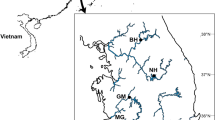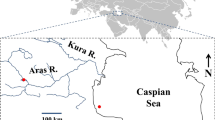Abstract
Intraspecific diversity of molluscan species is usually studied based on maternally inherited mitochondrial DNA, from which only part of the evolutionary history can be reflected. Some nuclear ribosomal RNA genes such as 28S rRNA represent potential candidates that can be easily applied in phylogeography because of lacking intraindividual variation. However, considering their low polymorphism, genetic appraisals on whether and how they can be used in population studies are necessary. Here, we applied a short 28S rRNA to assess genetic patterns of the clam Cyclina sinensis along the coast of China and compared the results with a former study based on COI and ITS-1 analyses. The results revealed the 28S rRNA data set was characterized by an extremely low level of variation, with only seven haplotypes defined for 93 individuals. Haplotype and nucleotide diversity for each population was almost the lowest when compared with the other two markers. However, the distribution of two dominant haplotypes showed clear geographic patterns, and significant population differentiation was revealed between the East China Sea and the South China Sea. These patterns were highly concordant with findings of the former study that populations of C. sinensis were historically separated by land bridges among sea basins. Our study suggested that although the nuclear rRNAs have shortcomings such as low variation, they have advantages including lack of intraindividual variation and high amplification rates. Applying rRNA genes can enrich the toolbox of nuclear markers in molluscan phylogeographic studies.
Similar content being viewed by others
References
Avise, J. C., 2009. Phylogeography: Retrospect and prospect. Journal of Biogeography, 36: 3–15.
Beheregaray, L. B., 2008. Twenty years of phylogeography: The state of the field and the challenges for the Southern Hemisphere. Molecular Ecology, 17: 3754–3774.
Clement, M., Posada, D., and Crandall, K. A., 2000. TCS: A computer program to estimate gene genealogies. Molecular Ecology, 9: 1657–1659.
Cutter, A. D., 2013. Integrating phylogenetics, phylogeography and population genetics through genomes and evolutionary theory. Molecular Phylogenetics and Evolution, 69: 1172–1185.
Dover, G., 1982. Molecular drive: A cohesive mode of species evolution. Nature, 299: 111–117.
Dupanloup, I., Schneider, S., and Excoffier, L., 2002. A simulated annealing approach to define the genetic structure of populations. Molecular Ecology, 11: 2571–2581.
Emerson, K. J., Merz, C. R., Catchen, J. M., Hohenlohe, P. A., Cresko, W. A., Bradshaw, W. E., et al., 2010. Resolving postglacial phylogeography using high-throughput sequencing. Proceedings of the National Academy of Sciences, 107: 16196–16200.
Excoffier, L., and Lischer, H. E. L., 2010. Arlequin suite ver 3.5: A new series of programs to perform population genetics analyses under Linux and Windows. Molecular Ecology Resources, 10: 564–567.
Excoffier, L., Smouse, P. E., and Quattro, J. M., 1992. Analysis of molecular variance inferred from metric distances among DNA haplotypes: Application to human mitochondrial DNA restriction data. Genetics, 131: 479–491.
Freeland, J. R., Kirk, H., and Petersen, S., 2011. Molecular Ecology. John Wiley & Sons, Ltd., Chichester, UK, 35–76.
Funk, D. J., and Omland, K. E., 2003. Species-level paraphyly and polyphyly: Frequency, causes, and consequences, with insights from animal mitochondrial DNA. Annual Review of Ecology, Evolution, and Systematics, 34: 397–423.
Hare, M. P., 2001. Prospects for nuclear gene phylogeography. Trends in Ecology & Evolution, 16: 700–706.
Hickerson, M. J., Carstens, B. C., Cavender-Bares, J., Crandall, K. A., Graham, C. H., Johnson, J. B., et al., 2010. Phylogeography’s past, present, and future: 10 years after Avise, 2000. Molecular Phylogenetics and Evolution, 54: 291–301.
Hurry, C. R., Schmidt, D. J., Ponniah, M., Carini, G., Blair, D., and Hughes, J. M., 2014. Shared phylogeographic patterns between the ectocommensal flatworm Temnosewellia albata and its host, the endangered freshwater crayfish Euastacus robertsi. PeerJ, 2: e552.
Kong, L. F., and Li, Q., 2009. Genetic evidence for the existence of cryptic species in an endangered clam Coelomactra antiquata. Marine Biology, 156: 1507–1515.
Lemer, S., Buge, B., Bemis, A., and Giribet, G., 2014. First molecular phylogeny of the circumtropical bivalve family Pinnidae (Mollusca, Bivalvia): Evidence for high levels of cryptic species diversity. Molecular Phylogenetics and Evolution, 75: 11–23.
Li, Q., Park, C., and Kijima, A., 2002. Isolation and characterization of microsatellite loci in the Pacific abalone, Haliotis discus hannai. Journal of Shellfish Research, 21: 811–816.
Librado, P., and Rozas, J., 2009. DnaSP v5: A software for comprehensive analysis of DNA polymorphism data. Bioinformatics, 25: 1451–1452.
Liu, J. X., Gao, T. X., Wu, S. F., and Zhang, Y. P., 2007. Pleistocene isolation in the Northwestern Pacific marginal seas and limited dispersal in a marine fish, Chelon haematocheilus (Temminck & Schlegel, 1845). Molecular Ecology, 16: 275–288.
May, R. M., and Godfrey, J., 1994. Biological diversity: Differences between land and sea [and discussion]. Philosophical Transactions of the Royal Society of London B: Biological Sciences, 343: 105–111.
Mikkelsen, P. M., Bieler, R., Kappner, I., and Rawlings, T. A., 2006. Phylogeny of Veneroidea (Mollusca: Bivalvia) based on morphology and molecules. Zoological Journal of the Linnean Society, 148: 439–521.
Ni, G., Li, Q., Kong, L. F., and Yu, H., 2014. Comparative phylogeography in marginal seas of the northwestern Pacific. Molecular Ecology, 23: 534–548.
Ni, G., Li, Q., Kong, L. F., and Zheng, X. D., 2012. Phylogeography of bivalve Cyclina sinensis: Testing the historical glaciations and Changjiang River outflow hypotheses in northwestern Pacific. PLoS One, 7: e49487.
Qi, Z. Y., 2004. Seashells of China. China Ocean Press, Beijing, China, 608pp.
Qiu, F., Li, H., Lin, H., Ding, S., and Miyamoto, M. M., 2016. Phylogeography of the inshore fish, Bostrychus sinensis, along the Pacific coastline of China. Molecular Phylogenetics and Evolution, 96: 112–117.
Rice, W. R., 1989. Analyzing tables of statistical tests. Evolution, 43: 223–225.
Schlötterer, C., 2004. The evolution of molecular markers—Just a matter of fashion? Nature Review Genetics, 5: 63–69.
Shafer, A., Cullingham, C. I., Cote, S. D., and Coltman, D. W., 2010. Of glaciers and refugia: A decade of study sheds new light on the phylogeography of northwestern North America. Molecular Ecology, 19: 4589–4621.
Turchetto-Zolet, A., Pinheiro, F., Salgueiro, F., and Palma-Silva, C., 2013. Phylogeographical patterns shed light on evolutionary process in South America. Molecular Ecology, 22: 1193–1213.
Voris, H. K., 2000. Maps of Pleistocene sea levels in Southeast Asia: shorelines, river systems and time durations. Journal of Biogeography, 27: 1153–1167.
Wang, P. X., and Sun, X. J., 1994. Last glacial maximum in China: Comparison between land and sea. Catena, 23: 341–353.
Xiao, Y. S., Zhang, Y., Gao, T. X., Yanagimoto, T., Yabe, M., and Sakurai, Y., 2009. Genetic diversity in the mtDNA control region and population structure in the small yellow croaker Larimichthys polyactis. Environmental Biology of Fishes, 85: 303–314.
Xu, J., Chan, T. Y., Tsang, L. M., and Chu, K. H., 2009. Phylogeography of the mitten crab Eriocheir sensu stricto in East Asia: Pleistocene isolation, population expansion and secondary contact. Molecular Phylogenetics and Evolution, 52: 45–56.
Zane, L., Bargelloni, L., and Patarnello, T., 2002. Strategies for microsatellite isolation: A review. Molecular Ecology, 11: 1–16.
Zeng, Z. N., and Li, F. X., 1991. The study of reproductive cycle of Cyclina sinensis. Tropic Oceanology, 10: 86–93.
Zhang, A. B., Kubota, K., Takami, Y., Kim, J. L., Kim, J. K., and Sota, T., 2006. Comparative phylogeography of three Leptocarabus ground beetle species in South Korea, based on the mitochondrial COI and nuclear 28S rRNA genes. Zoological Science, 23: 745–754.
Zhao, Y. M., Li, Q., Kong, L. F., Bao, Z. M., and Wang, R. C., 2007. Genetic diversity and divergence among clam Cyclina sinensis populations assessed using amplified fragment length polymorphism. Fisheries Science, 73: 1338–1343.
Acknowledgements
We thank Dr. Jie Bai from Shenzhen Genomics Research Institute and Dr. Ying Pan from Guangxi University for their kind help in sample collection. This study was supported by research grants from the Science and Technology Development Project of Weihai City (No. 2018NS01), the Industrial Development Project of Qingdao City (No. 20-3-4-16-nsh), and Guangxi Province (No. AA17204080-4).
Author information
Authors and Affiliations
Corresponding author
Rights and permissions
About this article
Cite this article
Ni, G., Li, Q., Kong, L. et al. The Clam Cyclina sinensis (Gmelin) Phylogeography Study with 28S rRNA Gene and Potential of Nuclear rRNA Genes in Genetic Assessments of Molluscs. J. Ocean Univ. China 21, 395–399 (2022). https://doi.org/10.1007/s11802-022-4845-1
Received:
Revised:
Accepted:
Published:
Issue Date:
DOI: https://doi.org/10.1007/s11802-022-4845-1




